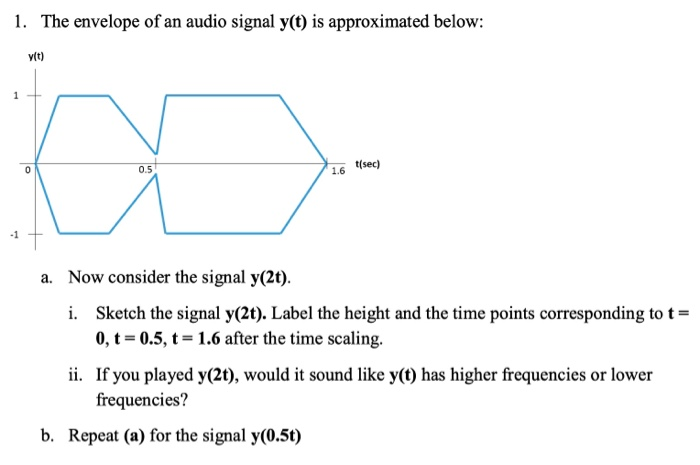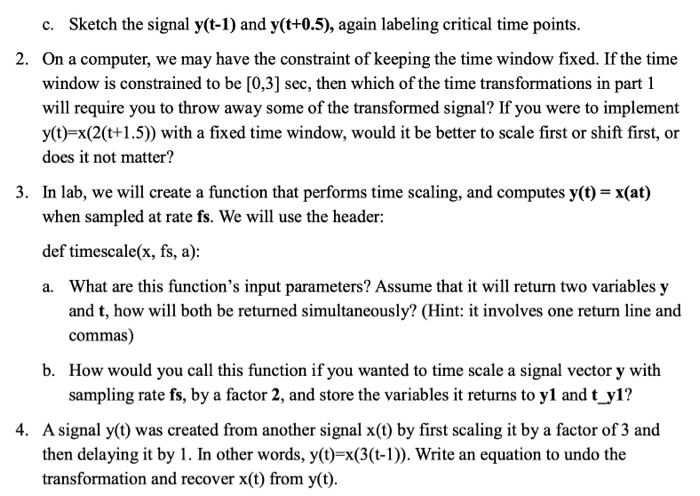Answered step by step
Verified Expert Solution
Question
1 Approved Answer
*** please use Python language *** The envelope of an audio signal y(t) is approximated below: 1. vt) 0.5 1.6 (sec) Now consider the signal
*** please use Python language *** 

The envelope of an audio signal y(t) is approximated below: 1. vt) 0.5 1.6 (sec) Now consider the signal y(2t). a. i. Sketch the signal y(2t). Label the height and the time points corresponding to t = 0, t = 0.5, t = 1.6 after the time scaling. ii. If you played y(2t), would it sound like y(t) has higher frequencies or lower frequencies? b. Repeat (a) for the signal y(0.5t) c. Sketch the signal y(t-1) and y(t+0.5), again labeling critical time points. 2. On a computer, we may have the constraint of keeping the time window fixed. If the time window is constrained to be [0,3] sec, then which of the time transformations in part 1 will require you to throw away some of the transformed signal? If you were to implement y(t)=x(2(t+1.5)) with a fixed time window, would it be better to scale first or shift first, or does it not matter? 3. In lab, we will create a function that performs time scaling, and computes y(t) = x(at) when sampled at rate fs. We will use the header: def timescale(x, fs, a): What are this function's input parameters? Assume that it will return two variables y a. and t, how will both be returned simultaneously? (Hint: it involves one return line and commas) b. How would you call this function if you wanted to time scale a signal vector y with sampling rate fs, by a factor 2, and store the variables it returns to yl and t_y1? 4. A signal y(t) was created from another signal x(t) by first scaling it by a factor of 3 and then delaying it by 1. In other words, y(t)=x(3(t-1)). Write an equation to undo the transformation and recover x(t) from y(t). The envelope of an audio signal y(t) is approximated below: 1. vt) 0.5 1.6 (sec) Now consider the signal y(2t). a. i. Sketch the signal y(2t). Label the height and the time points corresponding to t = 0, t = 0.5, t = 1.6 after the time scaling. ii. If you played y(2t), would it sound like y(t) has higher frequencies or lower frequencies? b. Repeat (a) for the signal y(0.5t) c. Sketch the signal y(t-1) and y(t+0.5), again labeling critical time points. 2. On a computer, we may have the constraint of keeping the time window fixed. If the time window is constrained to be [0,3] sec, then which of the time transformations in part 1 will require you to throw away some of the transformed signal? If you were to implement y(t)=x(2(t+1.5)) with a fixed time window, would it be better to scale first or shift first, or does it not matter? 3. In lab, we will create a function that performs time scaling, and computes y(t) = x(at) when sampled at rate fs. We will use the header: def timescale(x, fs, a): What are this function's input parameters? Assume that it will return two variables y a. and t, how will both be returned simultaneously? (Hint: it involves one return line and commas) b. How would you call this function if you wanted to time scale a signal vector y with sampling rate fs, by a factor 2, and store the variables it returns to yl and t_y1? 4. A signal y(t) was created from another signal x(t) by first scaling it by a factor of 3 and then delaying it by 1. In other words, y(t)=x(3(t-1)). Write an equation to undo the transformation and recover x(t) from y(t) 

Step by Step Solution
There are 3 Steps involved in it
Step: 1

Get Instant Access to Expert-Tailored Solutions
See step-by-step solutions with expert insights and AI powered tools for academic success
Step: 2

Step: 3

Ace Your Homework with AI
Get the answers you need in no time with our AI-driven, step-by-step assistance
Get Started


